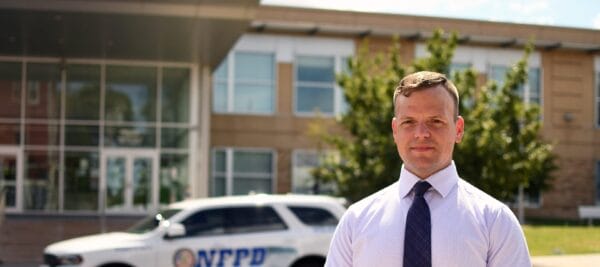The Program
The Public Safety AAS degree program at SUNY Niagara is designed to provide students pursuing a career in criminal justice with the unique opportunity to complete the Niagara County Law Enforcement Academy (NCLEA) as part of their academic program. During the first year, students complete 33 credit hours in foundational coursework in criminal justice and the social sciences, ensuring a strong academic base and a smooth transition into the specialized curriculum of the second-year Police Basic Training program with the NCLEA.
The program provides a clear pathway from the study of criminal justice to preparing for the practice of policing in New York State. Central to the program is the Police Basic Training program, delivered through the Niagara County Law Enforcement Academy, which fulfills the requirements of the New York State Division of Criminal Justice Services’ Basic Course for Police Officers. Students complete 30 credits of academy coursework.
Upon completion, graduates are well-prepared to pursue careers with law enforcement agencies or in a variety of roles within the broader criminal justice system. In addition, students may choose to transfer their credits to a four-year institution to continue their studies toward a Bachelor of Science degree.
Through rigorous academic instruction and hands-on training in partnership with NCLEA, graduates are prepared to apply New York State law, respond effectively to the challenges of policing, and contribute meaningfully to the safety of their communities.
The SUNY Niagara Approach
The typical program length for a full-time student will be two semesters of full-time classroom study followed by the 20-week Niagara County Law Enforcement Academy (NCLEA) Police Basic Training. The Public Safety AAS program admits students in Fall and Spring semesters. Law enforcement training academies typically begin in August and February. It will also be possible for students to transfer into this major after completing the Police Basic Training/Police Basic Training Certificate program.
- No minimum age requirement for program, however, students must be at least 19 years of age to participate in NCLEA training
- Must be able to pass Qualifying Physical Fitness Screening Test
- Must have high school diploma or equivalency
- Must possess a valid NYS driver’s license
- Must pass background investigation
- No felony/misdemeanor convictions
- Interview with co-directors
In order to be considered for employment, candidates must be a citizen or legal resident of the United States and may not have been convicted of a felony.
- Complete student application on SUNY Niagara Website
- Schedule and take the PT test
- Pass preliminary background
- Schedule interview with co-directors
If you are accepted, you will receive an acceptance letter from NCLEA
**Students applying to the SUNY Niagara program will not be automatically accepted into the academy. They must meet all requirements listed above**
- To address the public safety needs of Niagara County and the Western New York region by providing rigorous, collaborative training programs developed in partnership with local and regional public safety agencies.
- To produce a consistent pipeline of well-prepared graduates who are equipped to contribute meaningfully to the public safety workforce across New York State.
- To cultivate in students a sustained commitment to professional development and a proactive approach to lifelong learning within the field of public safety.
- To serve as a regional resource for public safety agencies operating within Niagara County and Western New York.
After completing this program, the graduate will:
- Demonstrate an understanding of criminal justice as a social science and relate other social science disciplines to the study of criminal justice and policing.
- Describe how the criminal justice system operates in New York State.
- Recognize how criminal justice policies are formulated and implemented while applying social science research and analyzing criminal justice data and statistics.
- Evaluate the pros and cons of the various controversial issues that confront the criminal justice system.
- Demonstrate working knowledge of New York State penal law, family law, mental hygiene laws, vehicle and traffic laws, and related other laws impacting the work of police officers.
- Apply the laws of the State of New York and the United States to the practice of policing.


